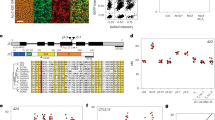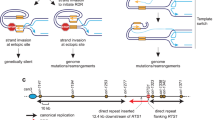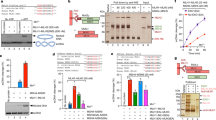Abstract
IN Saccharomyces cerevisiae, HO endonuclease-induced mating-type (MAT) switching is a specialized mitotic recombination event in which MAT sequences are replaced by those copied from a distant, unexpressed donor (HML or HMR1,2. The donors have a chromatin structure inaccessible for both transcription and HO cleavage1,2. Here we use physical monitoring of DNA to show that MAT switching is completely blocked at an early step in recombination in strains deleted for the DNA repair genes RAD51, RAD52, RAD54, RAD55 or RAD57. We find, however, that only RAD52 is required when the donor sequence is simultaneously not silenced and located on a plasmid. RAD51, RAD54, RAD55 and RAD57 are still required when the same transcribed donor is on the chromosome. We conclude that recombination in vivo occurs between DNA molecules in chromatin, whose structure significantly influences the outcome. RAD51, RAD54, RAD55 and RAD57 are all required to facilitate strand invasion into otherwise inaccessible donor sequences.
This is a preview of subscription content, access via your institution
Access options
Subscribe to this journal
Receive 51 print issues and online access
$199.00 per year
only $3.90 per issue
Buy this article
- Purchase on Springer Link
- Instant access to full article PDF
Prices may be subject to local taxes which are calculated during checkout
Similar content being viewed by others
References
Haber, J. E. Trends Genet. 8, 446–452 (1992).
Strathern, J. N. in Genetic Recombination (eds Kucherlapati, R. & Smith, G. R.) 445–464 (Am. Soc. Microbiol., Washington DC, 1989).
Raveh, D., Hughes, S. H., Shafer, B. K. & Strathern, J. N. Molec. gen. Genet. 220, 33–42 (1989).
White, C. I. & Haber, J. E. EMBO J. 9, 663–674 (1990).
Haber, J. E., Ray, B. L., Kolb, J. M. & White, C. I. Proc. natn. Acad. Sci. U.S.A. 90, 3363–3367 (1993).
Ivanov, E. L., Sugawara, N., White, C. I., Fabre, F. & Haber, J. E. Molec. cell. Biol. 14, 3414–3425 (1994).
Malone, R. E. & Esposito, R. E. Proc. natn. Acad. Sci. U.S.A. 77, 503–507 (1980).
Aboussekhra, A., Chanet, R., Adjiri, A. & Fabre, F. Molec. cell. Biol. 12, 3224–3234 (1992).
Petes, T. D., Malone, R. E. & Symington, L. S. in The Molecular and Cellular Biology of the Yeast Saccharomyces (eds Broach, J. R., Pringle, J. & Jones, E. W.) 407–521 (Cold Spring Harbor Laboratory, Cold Spring Harbor, New York, 1991).
Fishman-Lobell, J., Rudin, N. & Haber, J. E. Molec. cell. Biol. 12, 1292–1303 (1992).
Simpson, R. T. Progr. Nucleic Acids Res. molec. Biol. 40, 1896–1899 (1993).
Brand, A. H., Breeden, L., Abraham, J., Sternglanz, R. & Nasmyth, K. Cell 41–48 (1985).
Mahoney, D. J. & Broach, J. R. Molec. cell. Biol. 9, 4621–4630 (1989).
Collins, I. & Newlon, C. S. Molec. cell. Biol. 14, 3524–3534 (1994).
Bang, D. D., Verhage, R., Goosen, N., Brouwer, J. & van de Putte, P. Nucleic Acids Res. 20, 3925–3931 (1992).
Verhage, R. et al. Molec. cell. Biol. 14, 6135–6142 (1994).
Jensen, R. & Herskowitz, I. Cold Spring Harbor Symp. quant. Biol. 49, 97–104 (1984).
Nickoloff, J. A., Singer, J. D., Hoekstra, M. F. & Heffron, F. J. molec. Biol. 207, 527–541 (1989).
Rothstein, R. J. Meth. Enzym. 202–211 (1983).
Basile, G., Aker, M. & Mortimer, R. K. Molec. cell. Biol. 12, 3235–3246 (1992).
Schild, D., Calderon, I. L., Contopoulou, C. R. & Mortimer, R. K. in (eds Friedberg, E. C. & Bridges, B. A.) Cellular Responses to DNA Damage 417–427 (Liss, New York, 1983).
Rattray, A. & Symington, L. Genetics (in the press).
Lovett, S. T. & Mortimer, R. K. Genetics 116, 547–553 (1987).
Milne, G. T. & Weaver, D. T. Genes Dev. 7, 1755–1765 (1993).
Shinohara, A., Ogawa, H. & Ogawa, T. Cell 69, 457–470 (1992).
Ogawa, T., Yu, X., Shinohara, A. & Egelman, E. H. Science 259, 1896–1899 (1993).
Sung, P. Science 265, 1241–1243 (1994).
Kans, J. A. & Mortimer, R. K. Gene 105, 139–140 (1991).
Lovett, S. T. Gene 142, 103–106 (1994).
Emery, H. S., Schild, D., Kellogg, D. E. & Mortimer, R. K. Gene 104, 103–106 (1991).
Author information
Authors and Affiliations
Rights and permissions
About this article
Cite this article
Sugawara, N., Ivanov, E., Fishman-Lobell, J. et al. DNA structure-dependent requirements for yeast RAD genes in gene conversion. Nature 373, 84–86 (1995). https://doi.org/10.1038/373084a0
Received:
Accepted:
Issue Date:
DOI: https://doi.org/10.1038/373084a0
This article is cited by
-
The role of Drosophila mismatch repair in suppressing recombination between diverged sequences
Scientific Reports (2015)
-
Chromatin assembly controls replication fork stability
EMBO reports (2009)
-
Rad54 protein possesses chromatin-remodeling activity stimulated by the Rad51–ssDNA nucleoprotein filament
Nature Structural & Molecular Biology (2003)
-
Alternative lengthening of telomeres in mammalian cells
Oncogene (2002)
-
Gatekeepers of recombination
Nature (1999)
Comments
By submitting a comment you agree to abide by our Terms and Community Guidelines. If you find something abusive or that does not comply with our terms or guidelines please flag it as inappropriate.



